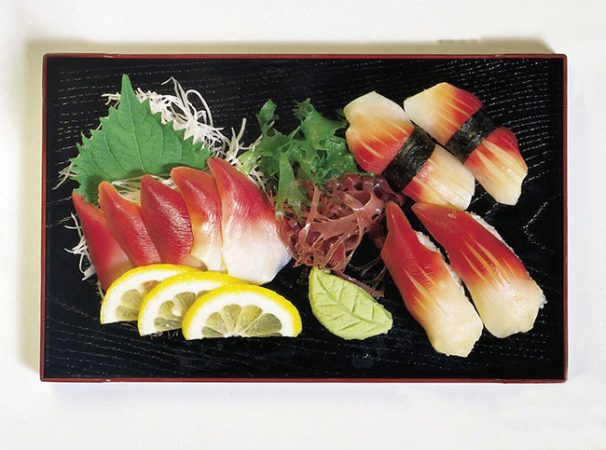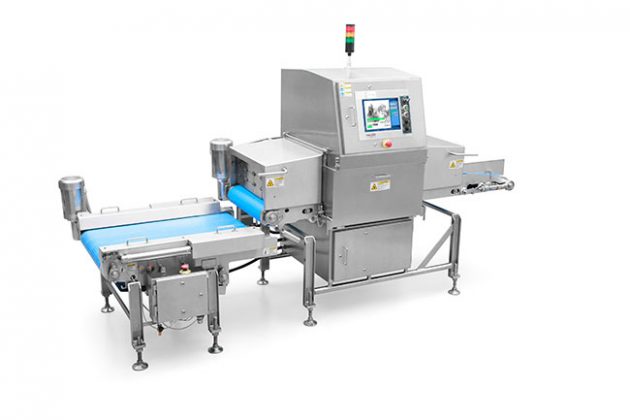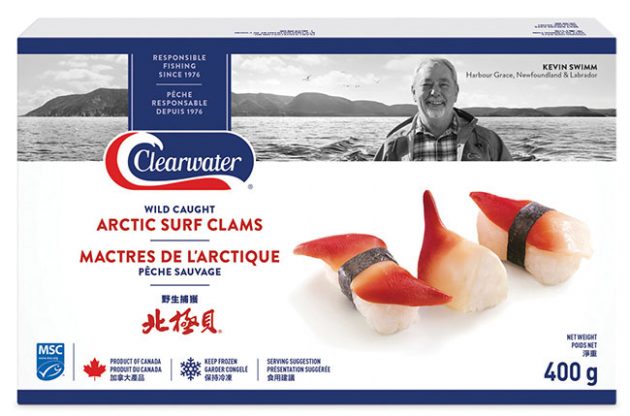
Happy as a Clam
George Guidoni
Food Safety X-Ray Clearwater Seafoods Inc. Eagle Product Inspection Eagle RMI3/B X-Ray Plan Automationcustomized high-speed X-Ray product inspection system helps Clearwater plant maintain world-class quality levels on its Arctic Surf Clam processing line
While Canada may be blessed with an abundance of delicious high-quality fish and seafood found in its coastal waters, turning that natural wealth into a lucrative sustainable business takes a tremendous amount of hard work, industry and perseverance.
Happily for folks at the Bedford, N.S.-headquartered fishery giant Clearwater Seafoods Inc., opening up new market opportunities at home and abroad with delicious innovative seafood products is a long-honed competence that has allowed the company to grow into one of the world’s leading seafood producers with vast geographic market reach and a world-class product portfolio.
“Since our inception in 1976, we’ve always remained focused on one goal—that Clearwater will be our customers’ wild, sustainable seafood supplier of choice by consistently delivering unsurpassed quality products,” says Darren Bowen, Clearwater Seafoods vice-president of global supply chain.
QUALITY CULTURE
As Bowen relates, “For over 40 years, Clearwater has invested in sustainability, research, technology and innovative solutions that affect every aspect of the seafood industry from ocean-to-plate.
“We’ve built our business with a willingness to take chances, develop new products and take them to new markets—key strategies we continue to practice today.”
According to Bowen, Clearwater currently sells over 93 million pounds of seafood annually in over 50 countries worldwide, with North America, Asia and Europe each accounting for roughly a third of its annual catch.
Boasting over 800 customers worldwide, “Clearwater serves the global seafood market with sales offices and distribution centres in some of the major regions we operate, including Canada, U.S., Argentina, U.K., Scotland, Shanghai, Guangzhou and Beijing,” according to Bowen.
“As a leading harvester, processor and marketer of sustainably-sourced seafood, Clearwater supplies its products to wholesalers, retailers and foodservice distributors globally under the Clearwater, Macduff and various private-label brands,” Bowen relates.
“Clearwater’s channel mix in foodservice, retail and other food industries ensures a diverse community of customers for our products.”
With a varied product portfolio comprising different species of scallops, lobster, crab, shrimp and other highly sought-after shellfish, Clearwater also happens to be the world’s leading processor and distributor of Arctic Surf Clams (Mactromeris Polynyma) caught in the waters just off Nova Scotia’s coastline and east of Newfoundland.
A portion of the Arctic Surf Clams harvested off Nova Scotia’s east coast are processed at the company’s Highland Fisheries plant in Glace Bay, located near the northern tip of Nova Scotia’s Cape Breton Island.
Acquired by Clearwater in 1987, the Highland Fisheries processing plant employs about 100 people from April to September, and about 50 from September to March, to process snow crab and Arctic Surf Clams for its global customers.

Housing a processing line for each of its primary species, the Highland Fisheries operation is one of the world’s leading suppliers of the wild-caught, sweet-tasting clam meat, popular in a multitude of global recipes and dishes.
Says Bowen: “Popular in Asian cuisines, Arctic Surf Clams are prized for their brilliant red tongues, making them visually appealing—particularly in sushi and sashimi dishes—or even in a delicate salad.
“Clearwater’s Arctic Surf Clams are available in a variety of sizes and formats,” says Bowen, noting that all clam products processed at Highland Fisheries are certified to the Marine Stewardship Council (MSC) global golden standard for third-party seafood verification.
“Through a multiyear strategy, Clearwater was successful in securing MSC certification for all core species in 2012,” Bowen relates.
“This means Clearwater offers the widest selection of MSC-certified species of any shellfish harvester worldwide,” he asserts, “including Arctic Surf Clams and snow crab processed at our Highland operation.”
Says Bowen: “We understand that the only way to continually bring high-quality shellfish to the marketplace is to ensure the long-term sustainability of the resource.
“That’s why Clearwater is directly involved with the science and management processes that are critical to sustainable fishing,” he states.
“Investing in the long-term health of the oceans and its bounty provides us a reliable, long-term supply of some of the best shellfish available in the world.”
Long prized for their sweet flavor, the Arctic Surf Clams are typically harvested from fishing vessels, which use a specialized fishing dredge, equipped with high-power hydraulic jets designed to fluidize the sea floor to loosen clams from the sediments before scooping them up.
The scooped clams are blanched and individually-quick-frozen (IQF) on-board Clearwater’s vessels in less than an hour of harvesting, thereby locking in the freshness, flavor and texture.
Upon arrival at the Highland Fisheries plant, the IQF clams are sorted, size-graded and rigorously tested.
“Only the finest sushi-grade clams make it through our demanding quality control process before they are shipped to satisfied customers around the world,” says Bowen, citing the plant’s rigorous food safety and quality assurance programs based on Hazard Analysis Critical Control Points (HACCP) management practices and the internationally-recognized BRC (British Retail Consortium) food safety certification.
According to Bowen, all Clearwater processing plants are continuously upgraded with the latest available technologies to help ensure consistently high levels of product quality to safeguard the company’s hard-earned reputation for seafood excellence.
MAKING THE GRADE
“As a vertically integrated company, our high food safety standards are applied to every level of our supply chain—from our vessels to our processing plants and through to our customers,” Bowen states.
“Everyone at Clearwater understands that the seafood we handle will become the centerpiece of our customers’ next meal,” Bowen says, describing the relatively recent installation of a high-quality new X-Ray product inspection system at the Glace Bay plant’s high-speed clam processing line.
Designed specifically for high-volume bulk product applications, the Eagle RMI3/B X-Ray inspection system, manufactured by Tampa, Fla.-based Eagle Product Inspection, came online in September of 2018 after a rigorous assessment, testing and demonstrations expertly carried out by PLAN Automation, Canada’s exclusive distributor of Eagle equipment headquartered in Orangeville, Ont.
Designed for high-speed inspection of unpackaged bulk products such as raw beef, pork, lamb, poultry and seafood for hard-to-detect contaminants like metal, glass, stone and calcified bone, this particular Eagle RMI3/B model was installed primarily to detect the many tiny shell fragments that naturally make their way into the clams’ flesh during the early processing stage aboard the vessels, along with any other unwanted contaminants.
With PLAN Automation having had already completed several packaging line projects at other Clearwater processing facilities, Bowen was confident that the Highland Fisheries installation would also meet Clearwater’s requirements.

Manufactured by Eagle Product Inspection and installed by PLAN Automation at Clearwater’s Highland Fisheries processing plant in Glace Bay, N.S., the high-speed Eagle RMI3/B X-Ray inpection system can detect even the tiniest shell fragments embedded in the raw clam meat processed at the plant.
That said, PLAN Automation’s vice-president and chief operating officer Mat Bédard says he knew that he had a formidable application challenge on his hands in meeting the plant’s demands for high throughput and accuracy.
“When dealing with raw products, bones and shells are some of the hardest contaminants to detect,” Bédard notes, “because of their low density.
“This Clearwater plant was having an issue with the deshelled clams coming off the boats with broken pieces of shell, so we had to optimize the system’s specific power setting to detect even the smallest shell pieces, as small as two or three millimeters in size,” he explains.
“In addition, we also wanted to give this system the capability for surgical removal of the clams with shell out of the product stream,” Bédard points out, “so it was a two-pronged challenge to both detect the shell and to surgically remove the problem clams.”
To enable this double-tasking capability, PLAN Automation custom-configured the system to remove all clams containing shell fragments off the fast-moving line into the reject bins below the system’s outfeed conveyor.
This involved installation of a special 20-nozzle air-blast mechanism, equipped with sanitary valves, to remove the identified problem clams from the product flow.
These separated clams are then passed through the system again in a single file with sufficient spacing between the clams, so that the system can again detect the contaminant and enable line operators to determine which clams can be reworked and salvaged, and which ones to remove from the process.
“When you are running the product in bulk form at speeds of up to 12,000 pounds per hour, you can often end up with four or five good clams being rejected for every true reject clam,” Bédard explains.
“Hence this system was designed to recirculate the rejected clams in order to separate the true reject clams from the ones that simply fell off the belt as part of that initial removal.
“By employing this double-pass method, the system enables very high-accuracy detection of clams that should be removed, while eliminating potential waste of perfectly good clams,” Bédard points out.
Operating with Eagle’s powerful proprietary SimulTask imaging software, available in 19 different languages, the RMI3/B X-Ray inspection system provides the same detection capabilities across the full size range of the processed
clams, which can vary from 1.5 to over four inches in length.
Naturally, the RMI3/B X-Ray inspection system has been designed to exacting industry standards for machine construction and sanitation, with Bédard citing the equipment’s NAMI (North American Meat Institute) approval rating for sanitation and cleanability “down to microbiological levels.”
Says Bédard: “These are heavy-duty machines that are literally built like tanks to ensure the most rugged and durable construction, along with cleanability.
“Weighing up to 3,000 pounds, they are designed to withstand high-pressure, high-temperature caustic washdowns required in meat plants.
“Moreover, they are equipped with specialty blue food-grade urethane conveyor belts that are also engineered to be completely cleanable to microbiological levels to ensure totally safe products.”

GOOD VIBRATIONS
In addition, PLAN Automation also equipped the machine with a customized vibratory infeed mechanism that arranges the clams into a single layer along the infeed belt to ensure more accurate detection capabilities.
“You don’t want the clams to be lying down on top of each other, as it would make it hard to detect the shells with high precision,” Bédard notes, adding it took PLAN Automation engineers about 12 weeks to complete all the required customization on the machine.
According to Clearwater Seafoods, it was time well spent.
“The high throughput, accuracy and the rejection system are all outstanding features and attributes of Eagle X-Ray technology,” says Bowen, “and the plant staff have indicated the technology is user-friendly and delivers project-defined results.
“All in all, the Eagle X-Ray technology has played a significant role in increasing productivity and defect resolution on the line,” Bowen concludes, “in addition to improving overall product quality for our Arctic Surf Clams.”
Advertisement

